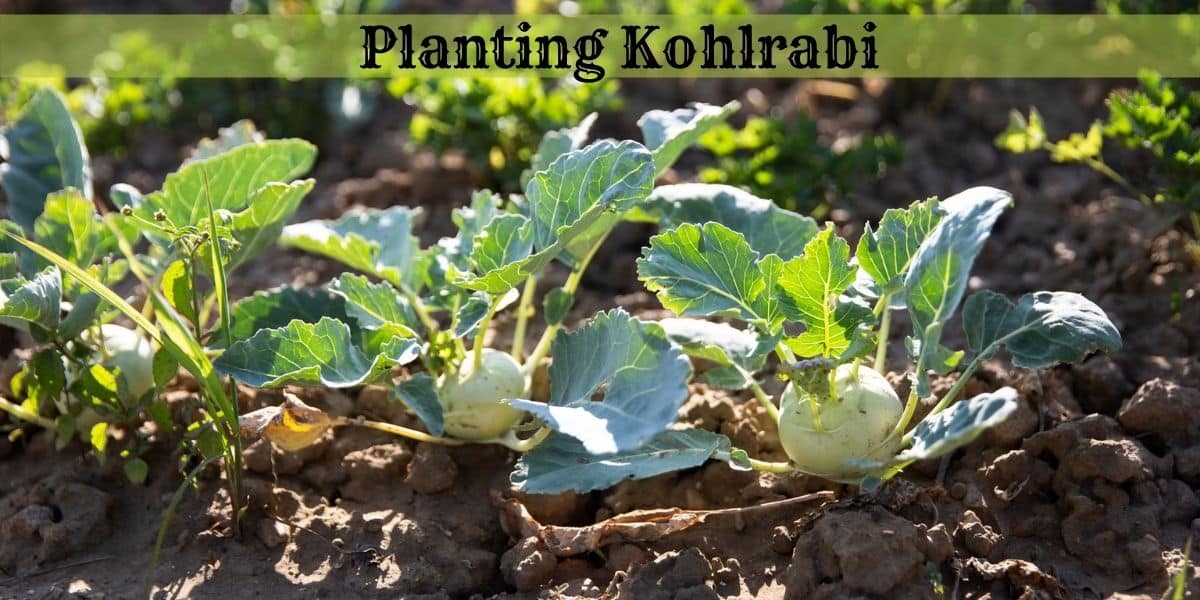Introduction of Planting Kohlrabi
Planting Kohlrabi, Before planting any vegetable, one should know about it well. so let’s have an overlook on
What is Kohlrabi?
Kohlrabi vegetable, otherwise called German turnip or cabbage turnip, is exceptionally mainstream in Northern and Eastern European nations like Germany and Hungary, just as in northern Vietnam and eastern India. Kohlrabi develops as a bulb with leaves shooting up from the sides, giving it a realistic outsider look. It very well may be white, green, or purple with little distinction in flavor and has a gentle taste that has made it mainstream in dishes from plates of mixed greens to soups.
Growing Kohlrabi leaves is an art. Stripping and hacking or cutting is the lone prep required. Ranchers like to plant the bulb since it is not difficult to develop a pair with different harvests and has a long developing season, making it a mainstream ranchers’ market find. Kohlrabi plant will, in general, be modestly valued when contrasted with other ranchers’ market veggies.
Table Of Content
History
Nutritional Facts
Planting
Harvesting
Growing
Fertilizers And Pests
Recipes
FAQs
Overview Of Kohlrabi
Biological Name
Brassica oleracea var. gongylodes
Plant Type
Vegetable
Maturity Period
45-60 days
Maturity Size
18 inches tall, 18 to 24 inches wide
Soil Type
Loamy And Sandy
Soil pH
Slightly acidic (5.5 to 6.9)
Exposure
Full Sun
Hardiness (USDA Zone)
2 to 11 (USDA)
Spacing
9-12 inches apart
Bloom Time
Summer
Toxity
Non-toxic
Flower Color
Pale Yellow
Growth Rate
45 to 60 Days
Native Zone
Northern Europe
Maintenance
Kohlrabi develops quickly, which means plants need a lot of water and compost. Keep soil sodden with a natural mulch, like straw, fertilizer, or grass clippings. Apply mulch when plants are 6 inches high, mulching straight up to the bulb.
History of Kohlrabi
The central portrayal of Kohlrabi was by a European botanist (1) in 1554. Before the end of the sixteenth century, it was known in Germany, England, Italy, Spain, Tripoli, and the eastern Mediterranean. It is said to have been first developed on a field scale in Ireland in 1734, in England in 1837.
Kohlrabi was created from the marrow cabbage, a wild type of cabbage that develops on the English Channel coast, European beachfront locales, and the Spanish peninsula. The marrow cabbage is a non-heading plant with a thick delicious stem. The plant has at times been known as the “stem turnip.”
Nutritional Facts Of Kohlrabi
The nutrients, minerals, and cancer prevention agents in Kohlrabi can give significant medical advantages. For instance, nutrient C aids the body ward off contamination and lessens irritation. Nutrient C can likewise further develop insusceptibility and lower cholesterol.
Growing Kohlrabi is likewise wealthy in folate, an effective supplement for pregnant ladies since it can assist with forestalling some birth abandons.
Metabolic Health
Kohlrabi is a low glycemic file food. Therefore, it can assist with further developing satiety and glycemic control. As a feature of a sound eating routine, Kohlrabi can assist with working on general digestion and help with weight reduction.
Cell reinforcement Properties
Notwithstanding nutrients and minerals, Kohlrabi is likewise wealthy in carotenoids and different cell reinforcements. Carotenoids shield the tissues in your body from free extreme harm that can prompt genuine infections.
Bone Density
Since Kohlrabi is high in calcium and magnesium, it adds to more grounded bones. Notwithstanding other calcium-rich food sources and weight-bearing activity, Growing Kohlrabi can be essential for fortifying bone thickness.
Kohlrabi Varieties
- ‘Early White Vienna,’ ‘Early Purple Vienna’: 55-60 days to development; sweet and gentle taste
- ‘Gigante’: 130 days to development; grows up to 10 creeps in width; stays fresh and sweet
- ‘Excellent Duke’: 50 days to development; can be left in the garden without getting extreme
- ‘Kolibri’: 45 days to development; delicate, white tissue; purple-veined leaves
- ‘Korridor’: 50 days to development; stores more extended than most different assortments
- ‘Kossak’: 80 days to development; grows up to 8 crawls in measurement; stores well
Planting Kohlrabi
Kohlrabi seed should be planted in the garden during April 15-16 until the first week of May. At a spacing of one inch, and should be deeper one-fourth to one-half. Stop planting after the first week of May. During this period kohlrabi will not produce the best quality because of the presence of heat.
Best time of planting kohlrabi
- Kohlrabi is a cool-season crop, so it is best filled in the cooler climate of spring or fall. For example, in hotter areas, the southern U.S. could be developed as a colder time of year crop.
- For a right on time to mid-summer collect, plant kohlrabi seeds inside in late winter, 6 to about two months before your previous spring ice date—stun plantings each 2 to 3 weeks for a nonstop gather. Solidify off seedlings before planting outside, as well.
- Then again, plant kohlrabi seeds straightforwardly into the nursery once soil temperatures have reached 45°F (7°C).
- For a fall or winter, gather plant seeds outside in mid-to pre-fall.
Steps of planting Kohlrabi
You may ask “how to plant kohlrabi” Instead of “steps of planting kohlrabi”. Both are the same question in different ways. Let’s go down to the next.
Kohlrabi is not challenging to develop, in any event, for novices. Landscapers who can hardly wait to get a leap on the season should add Kohlrabi to their initial entertainers like peas and radishes. Kohlrabi is freezing lenient and, in a perfect world, ought to be done with its developing cycle before soil temperatures warm up.
- Plant kohlrabi seeds straightforwardly in the nursery after the last hard freeze in spring, or plant in fall with sufficient opportunity to reap before the principal hard freeze.
- Press the seeds 1/4 to 1/2 inch deep into the dirt with 1-inch dispersing.
- For line planting, space the columns 12 inches separated. Slender the seedlings to 4 inches separated after prominent leaves create.
Note: Spacing may contrast for various plant assortments. For instance, monster kohlrabi assortments, which are liked for the more drawn-out fall season, should be cultivated with 4-inch dispersing and diminished to 12 crawls between plants.
Caring for Kohlrabi Planting
Light
Kohlrabi needs an entire day of sun to develop stout and foster its trademark flavor. Since this is a quick, early-season vegetable, you might have the option to plant it close to deciduous trees that haven’t leafed out yet.
Soil
Although Kohlrabi isn’t a root vegetable, it needs similar developing conditions you would give your carrots or radishes: wet, rich, topsoil. Twofold burrowing or raised beds will yield kohlrabi bulbs with delicate, non-pointed tissue.
Water
Keep Kohlrabi all around watered, which shouldn’t be troublesome in cool spring or fall soils. It ordinarily needs 1 inch of downpour or watering each week. For supplement support, water with manure tea each time.
Temperature and Humidity
In the same way as other cruciferous vegetables, for example, broccoli and Brussels sprouts, Kohlrabi fills best in a cool climate. At the point when summer temperatures show up, Kohlrabi is finished developing. Plants you didn’t find time to harvest will be incited by the warm climate to bolt or create blossoms.
Compost
Kohlrabi is a weighty feeder. It’s smarter to constantly take care of the plants by advancing the dirt with alterations that further develop tilth than by adding synthetic composts. Add fertilizer at planting time and side-dress lines with manure until collected.
Harvesting Kohlrabi
Harvesting Kohlrabi doesn’t go through an entirely recognizable shading change as it ages. However, you can depend on size as a determinant of collect availability. Youthful bulbs and foliage have the best surface and flavor, so pull the entire plant when the bulbs are somewhere in the range of 2 and 3 creeps in the distance across. Store bulbs in an excellent, dry spot to eat them with full preparation. The bulbs will save for a month in the cooler.
Like other cruciferous vegetables, the kind of Kohlrabi is brilliant on the day of gather and starts to decrease marginally every day from thereon. Truth be told, that Kohlrabi you see on the supermarket rack with somewhat shriveled leaves may even be a piece skunky—not a decent prologue to another vegetable taste sensation.
Kohlrabi leaves and stems are additionally consumable and can be eaten cooked (like caught greens) or crude. Eat the greens following harvest for the best flavor.
Growing Kohlrabi
Kohlrabi seed should be sown in the garden before 3-4 weeks from the last average snow-fall in spring. The best growth of Kohlrabi happens in winter in temperatures of between 40°F- 75°F (4.4°C-23.9°C). It needs 45 to 60 days to gain maturity.
Planting Kohlrabi in Pots
- Pick a pot essentially 300mm wide and profound and position it in a bright spot. Load up with quality preparing blend, like Yates Premium Potting Mix.
- Plant seed directs into the dirt, planting them in clusters of 2-3 seeds. Cover gently with Yates Black Magic Seed Raising Mix and water well.
- Water consistently. When seedlings arise, thin seedlings at each bunch to the most grounded, feed week by week with Yates Thrive Natural Fish Seaweed+ Plant Food Concentrate.
- Gather by pulling the bulbs early or when the bulbs are between 5-7 cm in measurement. Sow progressive yields each 4-5 weeks to expand your collect window.
Propagation
Plant the seeds, half inches down, straightforwardly in the pot. When the roots grow, dainty out the seedlings, leaving just a single solid plant for every pot or container. Relocate the dispersed seedling in the nursery. Another alternative is purchasing child kohlrabi plants from a nursery and relocating them in pots.
Troubleshooting While Growing Kohlrabi
Albeit the mere nuisances that, like cabbage, can likewise assault Kohlrabi, it is for the most part less disturbed by aphids, slimy root parasites, cabbage worms, and different caterpillars. Clubroot and dark decay infections in the dirt can be an issue.
Fertilizers And Pests
Forestall cutworms by spreading diatomaceous earth around young plants or by utilizing collars around plants. Handpick caterpillar bugs like the cabbage worm. You can likewise eliminate egg bunches from the undersides of leaves.
Fertilizers And Pests. Kohlrabi is not an excessively substantial feeder. Preparing with 3-4 quarts for every 100 sq feet (3.3-4.4 liters per 9.3 square meters) of a decent natural universally handy 5-5-5 compost roughly fourteen days before Kohlrabi planting or relocating will ordinarily own a yield gather in many nurseries.
Kohlrabi Recipes
Roasted Kohlrabi
Kohlrabi Curry
Fried Kohlrabi
FAQ
How Far Apart Do You Plant Kohlrabi?
Space plants 9-12 inches separated. Time to Germination: 3-10 days Special Considerations: Kohlrabi doesn’t fill well in free soil.
Is Kohlrabi Easy To Grow?
Growing Kohlrabi isn’t the hardest thing on the planet, as kohlrabi is entirely simple to develop. Start your plants inside around four to about a month and a half before you intend to put them outside.
What Can You Not Plant With Kohlrabi?
You should not plant peppers, pole beans, strawberries, and tomatoes along with Kohlrabi.

